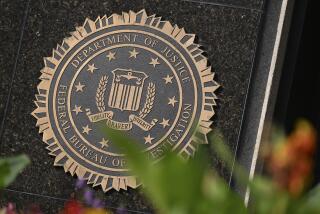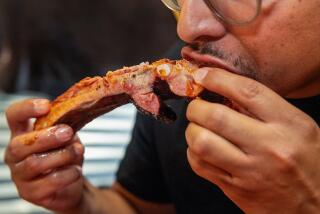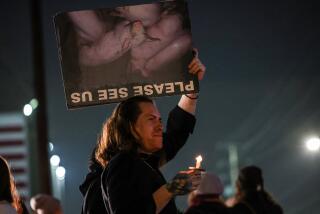It’s a war on boars, but pork’s winning
Edom, Texas
It was a cool Saturday night in East Texas, and many men were surely someplace warm, swilling beer and watching football. That was not Joe Paddock’s idea of good times.
Covered in camouflage and carrying an AR-10 assault rifle, night-vision goggles and enough ammo to outfit a small battalion, Paddock was wading through weedy bottomlands, eager to “get up on some hogs,” as he excitedly put it.
Two packs of wild boars on a retired fire marshal’s ranch had eluded his scope for weeks. This time, he promised, the clever pigs would pay.
“It’s become like a vendetta to me,” Paddock whispered. “These hogs have got my number. It’s like they’re tracking me.”
Paddock, who looks like long-haired rocker Ted Nugent, is a pig-killing hit man who calls himself “The Dehoganator” and advertises his services.
If a band of feral swine is laying waste to your land -- an increasingly pervasive problem in the Lone Star State -- The Dehoganator and his fellow riflemen will happily shoot ‘em up to hog heaven, as long as you help cover the cost of the bullets.
California and other states struggle to rein in feral swine, but nowhere are the pigs more populous than in Texas. It’s home to about 2 million wild hogs -- and they’re multiplying.
Of the 254 counties in Texas, about 90% have a wild hog problem. Surly pigs have been spotted in urban parks in Dallas and San Antonio, startling joggers. Mobs of ravenous porkers are munching crops and tearing up hayfields, causing $52 million a year in damage, state officials estimate. They also are eating the eggs of endangered sea turtles on coastal barrier islands, forcing biologists to scurry nests to safety.
“The feral hog population in Texas is completely out of control,” said Kevin Ryer, founder of a website called Texasboars, where hunters and trappers share photos and bravado-filled tales. “There’s not a big city in Texas that doesn’t have a hog in it somewhere.”
Texas’ plague might be a menace to landowners, but for Paddock, who makes his living trimming trees, it’s a chance to have a little fun. He’s spent more than $20,000 amassing a stockpile of swine-killing weapons, and admits that playing The Dehoganator is a money loser. But that hardly matters to him.
To many country-bred men like Paddock, 47, hunting wild hogs is the ultimate blood sport: a battle of wits against an ugly, wise and unpredictable foe. Anybody can shoot Bambi in the woods, they argue, but bringing down an angry 300-pound boar takes bravery. Wounded hogs can turn vengeful. Men have been gored to death by their “cutters,” or razor-like tusks.
“The hog is the poor man’s grizzly,” said Tommy Stroud, 45, one of Paddock’s riflemen. “If you shoot at a hog, you’d better shoot straight, because if you don’t kill it, he might try and kill you.”
Still, despite an increase in part-time swine hunters like Paddock -- and a thriving culture of trappers who earn thousands sating gourmet appetites for wild boar in the United States and Europe -- the consensus among scholars and government officials is that the hogs are winning.
Federal agriculture officials have resorted to gunning down pigs from helicopters. State officials have declared open season on them: Hunters can shoot as many as they want, any time. Here in Van Zandt County (pop. 48,140), leaders put out a bounty four years ago, promising $7 for every pair of hog ears brought in. They got more than 2,000 and ended the offer a year later.
Experts say there is a simple reason for the expanding number of boars: They are smarter than people think. As one meat buyer put it, “Ain’t nothing easy about trying to outsmart a pig.”
Paddock was painfully learning that lesson once again. This night, he scoured the ranch for signs of porcine life and saw them everywhere: cloven hoofprints on the shore of a pond, hair bristles on tree trunks where fat hogs scratched themselves, and full body prints on puddles where they wallowed in the mud.
But as he slunk along the bottomlands, beneath a black, moonless sky, the sole sound Paddock heard was the soft thump of acorns falling. There were no hogs in sight.
“It’s going to be a long night,” Paddock said, and crept on.
Hernando de Soto, the Spanish conquistador, brought the first pigs from Europe to what is now the mainland United States in 1539. Some later ran loose after escaping their colonial masters. But it was not until the 1930s, when sportsmen began releasing Russian boars into the wild, that the true trouble started in Texas.
The hunters underestimated the boars’ intelligence, as well as their rabbit-like reproductive tendencies. Soon the mongrel offspring of fierce Russian boars and fat domesticated pigs were as common in Texas as mesquite.
Officials in Oregon and Kansas still believe they can eradicate wild pigs. But in Texas, it’s too late. The only hope, according to those who study the problem, is to contain the destruction they wreak when rooting up fields in search of grubs, and the diseases they spread to livestock and house pets.
Carol Acedo just wants to scare the hogs away from her house. The artist, who lives next to a nature preserve about 15 minutes from downtown Fort Worth, was letting her dog out one evening last year when, she said, “I heard a snort.”
Days later, she heard rustling in the bushes, “like something was coming at me.” A few days after that, she heard snorts again and summoned the courage to shine a flashlight. She saw 10 pigs in her frontyard.
“They were just tearing up my land, looking for acorns from the oak trees,” said Acedo, 42. “It was like a tractor tilled it up.”
She tried to hire hunters, but they were wary of firing in a residential area. Eventually the boars left, but she believes they’ll be back now that acorns are dropping again.
She hated to do it, but she got a shotgun.
One woman’s swine is another man’s free-range pork, however. In Jermyn (pop. 75), about an hour and a half from Acedo’s house, seasoned trapper Kim Rife is making six figures selling hogs to meat companies, which in turn sell the “lean and nutty” wild boar cuts to high-end supermarkets and fashionable restaurants.
Rife, 72, runs a booming “animal control” business across 18 counties, trapping skunks, raccoons, coyotes, turtles, rattlesnakes and other critters ranchers deem pests. He sells raccoon furs to rug makers and snake blood to Korean women who believe it will make their men sexually ravenous. But the big profits come from the hogs. “Look as far as the eye can see,” Rife said, sweeping his hand across an expanse of mesquite trees and golden ragweed bushes once owned by a cattle baron who inspired the novel “Lonesome Dove.” “You can’t see ‘em, but every acre’s crawling with hogs. For eight years, I’ve caught a hog every day.”
He pulled up to a wire cage at the edge of a wheat field, and a smile overtook his face. Five young boars were inside, screeching.
“Hey boys! What you doing in my trap?” Rife said, adding, “I’ve caught enough hogs in this one alone to buy me a new truck.”
Wild hog sellers say their trade is a capitalist solution to Texas’ pig problem. “If it wasn’t for the market to sell this stuff, hogs would be thicker than mosquitoes,” said Danny Sturness of Frontier Meats, the company that buys Rife’s hogs.
Wildlife experts disagree.
“Do the math: When you have 2 million pigs having three litters every two years, you’re not going to eat your way out of this,” said Mike Bodenchuk, the U.S. Department. of Agriculture official in charge of Texas wildlife problems. “These pigs are an ecological train wreck.”
It was nearly midnight back at the fire marshal’s ranch, and rifleman Stroud said his feet hurt. He was going home.
That was probably for the best, Paddock and his remaining rifleman, Kit Rackow, reasoned later. Stroud had been passing gas all night -- the offensive exhaust from a three-chili-dog lunch -- and hogs have uncanny hearing and sense of smell.
The evening’s only swine sighting had been brief and action-free: Rackow spotted a sow and two piglets. But he couldn’t get off a shot before they ran back into the brush.
As the hunt dragged on, the air got chillier, and a dense fog began blanketing the bottomlands. Paddock’s night-vision scopes were useless now. Even his spotlights could only penetrate a few feet before fading into gray.
The hunt’s prospects looked bleak, and both men knew it. But Paddock refused to give in.
“I’m going to shoot a hog or the sun’s coming up,” he said stubbornly.
Since he began shooting the ranch’s swine, Paddock explained, his quarry would creep out later every evening in hopes of avoiding him. But eventually, he said confidently, they would have to come out to eat.
Around 2 a.m., coyotes began to howl; the woods were coming alive at last. A racket down the hill from where the hunters were scanning the panorama made them jump. It was a false alarm: just a few loose horses that roam the 600 acres.
Suddenly, Paddock noticed something, and a look of defeat formed on his face. The winds had shifted, and were moving past the hunters and down into the creek bed where he thought the hogs were holed up. That meant the swine could smell him before he could see them.
A dejected Paddock finally folded shortly before 3 a.m.
“These hogs have made a fool of me,” he said sadly. He walked to his pickup and drove home.
Paddock was right -- they had. When he returned after daybreak, he found a hayfield torn asunder. Shielded by the fog, the hogs had been just 50 feet away, pigging out all night long.
--
More to Read
Sign up for Essential California
The most important California stories and recommendations in your inbox every morning.
You may occasionally receive promotional content from the Los Angeles Times.










